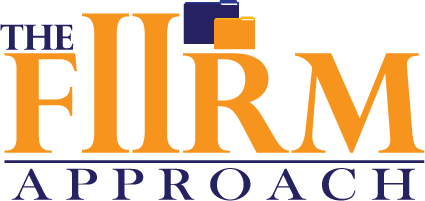
Easy Ways to Organize Money Before Year End
Taking the First Step Towads Organizing Your Money
Trying to organize money can feel like scrambling eggs, flipping pancakes, and trying not to burn bacon at once.
And for working moms, professional women, and divorced women, the financial circus can seem even more intense – trust me, I know.
Fear not, because it’s not too late to turn your financial chaos into organized bliss.
The first step is often the hardest, and it’s the part we usually want to skip.
Here’s how you can confidently level up your money management game and consistently achieve financial goals regardless of how much money you have.
5-7 min read: Looking for the audio version of this blog post – Sign up for the FIIRM Hero Newsletter Community to HEAR what this post is all about when you don’t have time to read it.

What is the First Step to Organized Finances?
The best way to organize your money is the way that works best for you.
But I can’t think of any reason why the following steps wouldn’t be helpful as outlined in this first section. These first few actions are helpful for single, married, and post-divorce women.
Set Clear Priorities
Decide which area of your finances needs the most attention. What’s important? What is more urgent?
Only try to tackle a few things at a time if you are working on your financial health alone (no financial team, financial bff, or romantic partner). Think about the different ways in which your finances are affected the most.
Do unexpected expenses throw you completely off track? Do you need to focus on paying off debt, saving for a goal, controlling your spending habits, or just taking control of your finances?
Create a Plan
Outline the financial decisions you need to make to achieve your priorities. Be specific and set deadlines to keep yourself accountable.
Document the plan, which includes your budget, by writing it down or using an app to track your goals (see below for more guidance). You don’t need to map out the plan for the year; start with the next 90 days.
Take Action
There is no such thing as a perfect moment, so please don’t wait for the ideal moment to start.
Commit to taking action because small actions lead to significant results over time. Which leads me to the next step…
How to Set Financial Goals You Can Actually Achieve?
The best way to set your financial goals is in alignment with your upcoming milestones and transitions.
Setting financial goals is like plotting a road trip’s route— you might get lost without a map. Think about your intentions for this year – what do you want to achieve? What has gotten in the way of you making those things happen?
Break Down Big Goals
Significant financial goals can be intimidating, and there’s a high likelihood that you won’t reach them if they are too lofty.
Breaking them into smaller, manageable, realistic steps is a good idea.
For example, if you want to save $5,000 for a down payment in 6 months, it might sound ok to write down that goal.
However, suppose your financial life won’t let you be great because can’t put $833.33 into your savings account over the next 6 months. Because you rarely have $833 left over at the end of the month.
In that case, your goal needs to be adjusted. That may mean saving for longer or reducing the down payment amount. This will make your savings goals realistic and, most importantly, achievable.
Track Your Progress
When it comes to personal finances, seeing your savings grow or your credit score improve can be incredibly motivating. Monitoring your progress with a spreadsheet or a budgeting app is a great way to do this.
You can also set up alerts for your checking account activity, credit cards, bill payments, due dates, etc. You name it, there is probably an alert for it.
Alerts often help you avoid or reduce late fees and spend a little less time reviewing bank or credit card statements. Almost every financial institution allows you to set up an alert on your financial accounts.
These alerts can help you avoid unnecessary fees and provide peace of mind that your accounts are being monitored.
Stay Flexible
Life happens, and sometimes you need to adjust your goals. Whether it’s saving for a family vacation or building an emergency fund, clear goals will keep you focused.
Suppose your son or daughter is graduating from high school, and it’s time to buy yourself a new car.
In that case, your family vacation may not be as long or as luxurious as you would like it to be, depending on how your cash flow is set up. Flexibility allows you to adapt without getting discouraged.
If you know you have good habits, then little hiccups won’t mess you up in the long term.
Plan for Fun
Personal finance isn’t all about deprivation. Set aside funds for fun activities to keep life enjoyable and see the fruits of your labor.
What’s the Best Way to Simplify Your Financial Life?
Tracking bill payments, important documents, investment accounts, and financial records can suck, but it can make it easier to organize your money.
Simplifying your financial life can reduce stress and make money management more effortless. This is super important for your post-divorce life as your world has likely been turned upside down, and you need things to be more accessible.
You may need more good days than bad ones, and simplifying your financial life can help.
Consolidate Accounts
If you have multiple checking or savings accounts, consider consolidating them if you are not using them. Also, consider reducing the number of financial institutions where you have accounts. Fewer accounts mean less to keep track of.
Automate Your Accounts
Set up automatic payments for bills. This ensures you’re never late and saves you the hassle of remembering due dates. If your cash flow is inconsistent, you can still use your bank’s online bill payment system to set up the payments manually. This gives you more control over how you pay bills.
Set Up Direct Deposit
This way, you’re saving before you touch the money.
Automate your savings so that a reasonable portion of your paycheck is automatically deposited into your savings account.
By setting up automatic transfers, you can grow your savings over time.
Reasonable is the trick here, but you decide if 5% or 25% makes sense for your long-term goals. If that’s not feasible, you can set up automatic transfers directly from your checking account to your savings account for an easy way to save consistently.
Go Digital
Use an online banking mobile app and budgeting app to manage your finances. Digital tools can provide real-time insights and make tracking easier. Apps like Acorns, Qapital, and Chime round up your purchases to help you reach your savings or investing goals. It’s an easy way to save without even noticing.
How to Organize Your Financial Documents & Your Credit Cards?
An organized money system, including keeping your financial documents organized, can save you time and reduce stress. Credit card management can be tricky. When credit cards are used wisely, they can be a great financial tool. Here are some simple ways to organize your financial documents:
Create a Filing System
A good system can be digital, physical, or a combination of the two. Most of us receive some statements online as well as paper statements. You may still have a physical filing cabinet or leverage digital tools like Dropbox. As a Certified Divorce Financial Analyst (CDFA®), I know firsthand that setting up your filing system and keeping everything in its proper place are important steps if you are planning to divorce. Guess what, though? It’s equally important when you are planning to get married. If you take the time to do this, you’ll also be a dream client for a financial advisor.
Go Digital
Whenever possible, opt for digital statements and receipts. Digital documents are easier to organize, take up less space, and reduce financial clutter.
Some credit card companies allow you to have a virtual credit card number. This number is usually different from the card number on your physical card and provides a better sense of security.
Capital One allows you to set up a unique number for each vendor, which makes it easier to stay organized about who has your card number on file.
Regularly Review and Purge
Periodically review your documents and discard anything you no longer need. Start by checking your credit report for mistakes.
Dispute any inaccuracies you find. Keeping only essential documents reduces clutter and makes it easier to find what you need. Bank statements, ATM, and credit card receipts can be discarded once reconciled unless required for tax purposes. Shred expired credit cards!
Get rid of your expired debit card. But it’s best to hold onto documents that are difficult to replace. Some of those are listed below:
- Adoption papers & birth certificates
- Citizenship Documents
- Death Certificates
- Divorce Decree & Marital Settlement Agreement
- Estate Documents
- Marriage License
- Military Discharge Papers
One last helpful note to support your financial success. There is no need to carry all of your credit cards in your wallet. While it may require more planning on your point, limit the cards you carry in your wallet. Carry the cards you’ll need that day or that week and place the rest in a secure spot.
Discovering the Best Way Forward
We are all unique. What works for one person might not work for another. Here are two simple things that can help.
- Experiment & Seek Advice: Build your financial team with the right advisors to get advice. You’re not expected to know everything and an outside perspective can help with complex decisions.
- Stay Committed: Financial organization is a continuous process. Stay committed to your plan, take a closer look at your money goals regularly, and make adjustments as needed.
Wrapping Up Your Journey to Organizing Your Money
This post was all about the best ways for women to organize their money. Organizing your finances doesn’t have to be overwhelming. You can achieve financial clarity and peace of mind by:
- Setting clear financial goals
- Leveraging tools like budgeting apps and automation
- Remember, the key to success is taking that first step and continuously making progress.
Ready to take your financial organization to the next level? Need some assistance? The FIIRM Approach helps female breadwinners protect their financial security and improve how you manage your financial life.
Let’s connect to see how the FIIRM Approach can provide you with personalized strategies and guidance that work for your needs. Sign up for the FIIRM Hero newsletter community and get access to free information.
Start your financial transformation today and make 2024 your best financial year yet!

Nikki Tucker
Founder & Managing Director
Nikki is an experienced financial services professional, a Certified Divorce Financial Analyst ®, and the primary divorce financial strategist for The FIIRM Approach. She helps female breadwinners prepare for divorce to avoid common financial mistakes and confidently maintain their financial security post-divorce. She uses proven strategies within the FIIRM Approach methodology so her clients can manage their money, debt, and credit and be connected to the right resources for the next phase of life. TAKE ACTION & LEARN about the tools that can help make your pre and post-divorce easier. Grab your FREE Divorce Support Pack.
